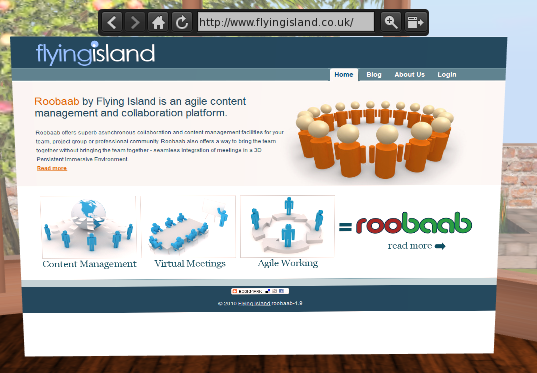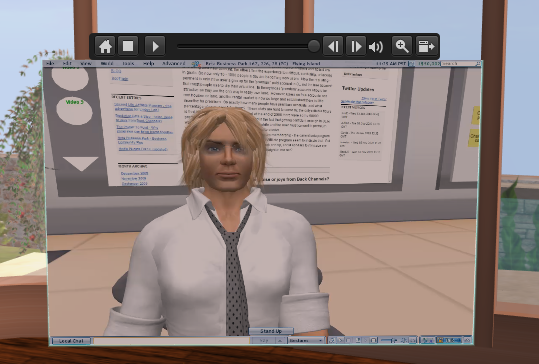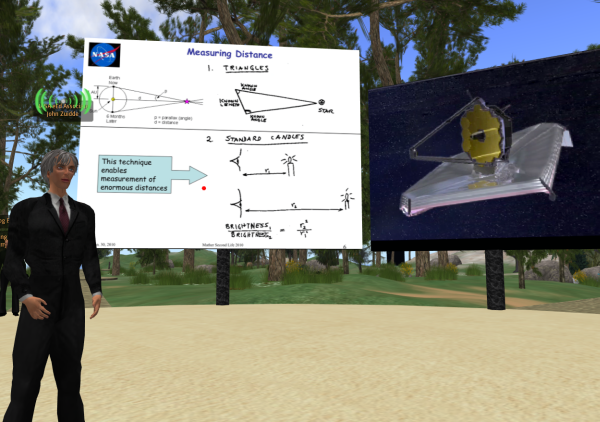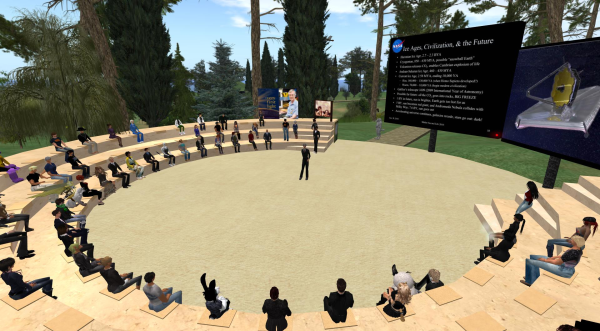Who, What, Why?
Enterprise uses of Immersive Environments and Virtual World technology for collaboration. As CTO of vComm Solutions and co-founder of Flying Island I'm particularly interested in the ways that collaborative 3D immersive environments might help bring dispersed teams together
Neil Canham
This Month
| February 2010 |
| Sun |
Mon |
Tue |
Wed |
Thu |
Fri |
Sat |
|
|
1
|
2
|
3
|
4
|
5
|
6
|
|
7
|
8
|
9
|
10
|
11
|
12
|
13
|
|
14
|
15
|
16
|
17
|
18
|
19
|
20
|
|
21
|
22
|
23
|
24
|
25
|
26
|
27
|
|
28
|
|
Tuesday, February 23

SL Viewer 2.0 Guide to Shared Media on a Prim
by
neilC
on Tue 23 Feb 2010 18:12 GMT
Essentials: You can now display fully interactive, shared web content on any surface in Second Life including flash, javascript, and embedded movies. On any surface of any object. A different browser on all six sides of a cube if you want. When you change the displayed URL by clicking on a link, everyone else sees that change. Scrolling isn't shared. Details: The new Second Life viewer is now officially in open beta and available to the world. Amongst the huge raft of UI changes, about which vast tomes will undoubtably be written, there is also the totally new media functionality. It is now possible to create multiple panels in the 3D environment each of which is a fully fledged web browser allowing scrolling, clicking on links, text entry, full javascript support and flash. Anything you can do in a browser you can do on a suitably configured panel. The old constraints of parcel media having one URL per parcel are gone. Any surface of any prim can be configured as a browser, and the closest 8 to your camera will be displayed at any one time. The media are shared in the sense that when the displayed URL changes, either through you typing in a new link or clicking a link then that URL is distributed to everyone else who will see the change within a few seconds. Sadly, scrolling is not similarly distributed, at least not in the build of the viewer that I tried. This slightly dampens my enthusiasm as it means I can't use a pointer to point at the browser and know everyone else sees the same thing. (If shared scrolling is something you need, contact me as my company Flying Island are enhancing the browser with shared scrolling for selected content). I'll provide a separate tutorial on configuring a surface as a media player, and also how to script the media. Scripting is already there with new functions to read the currently displayed URL and set w new one, as well as changing other settings. Importantly you have good control over who can interact with the media, and this too is scriptable. You can also create and manipulate a whitelist of acceptable URLs - you don't want vistors leaving nasty suprises on the browser. The other thing you can do of course is script the panel to reset and return to it's homepage if there's no one near it. The new UI supports several features to help interact with the new media features. When your mouse hovers over a media surface, a small icon bar pops up allowing you to enter a new web address, or go forward/back/home. At this point, the media surface does not have focus. However, if you left click on the surface, a faint green outline appears. It now has focus, and your keystrokes now go to the browser. In addition on the popup navigation bar there is a magnifying 'zoom' button - pressing this zooms and centers the surface for easier viewing.  If the surface is configured to display Quicktime-playable content, a different navigation bar appears, with volume control and elapsed time display  This new shared media functionality is provided by the new SLPlugin architecture in the viewer. SL Viewer 2.0 comes with 2 plugins, one for displaying web pages and one for Quicktime. The plugins launch as separate processes, on a windows machine you will see up to 8 SLPlugin.exe processes running. There are already other plugins being worked on, including one that supports VNC desktop-sharing protocol and since the API is public, the expectation is that people will develop more. Mind you, with the full browser support now available, a huge raft of possibilities open up even without new plugins - shared whiteboarding and collaborative reviewing and editing being the most obvious to me. This really is going to make a huge difference to what can be done in SL, certainly for enterprise and education uses. Along with all the other changes in Viewer 2.0 this has me all fired up about SL again. Great work!
Wednesday, February 3

As if by Magic, a Conference Call appeared...
by
neilC
on Wed 03 Feb 2010 21:40 GMT
When we first formed Flying Island we would hold regular skype conference calls. It was useful (and free) but frustratingly clunky to use. If one party dropped out, as they regularly did, more often than not we'd have to restart the entire call. Sometimes I'd try to reconnect, only to end up in a one to one conversation. If some colleagues were already in a group call, I couldn't just join in. If we'd been in the same physical space it would have been so much simpler - just walk up to the group of people you need to talk with, and start talking... shouldn't a conference call be as easy?
The voice chat integration in SL gets slated but my experience has been overwhelmingy positive. The niggles that are there should hopefully be removed with the auto-level adjustment and echo cancellation that are due to be part of the Viewer 2.0 release in March. The huge 'aha' moment for me happened after a Show and Tell gathering at the Beta Business Park in SL - around 10 of us had been voice chatting, swapping our best discoveries of the previous week. When the meeting broke up, I noticed that some of the Flying Island founders were online in the office on the park. I walked my AV across the park and into the office, as I entered I could hear them talking, and I simply sat down and joined the meeting. Effectively I'd gone from one 'conference chat' with 10 people to another with 3 other people in exactly the same way I would have done in a physical space - by walking from one group to the other. No menus, commands, connections to negotiate, it just worked. The voice integration has other nice features too. Working out who is talking is quite natural, helped by many mechanisms built into the environment - spatial cues with the sound appearing to come from the correct place relative to your field of view, glowing 'vu-meter' above the speaking avatar and various animations during speech. Also, if you need privacy then lock the parcel of land you are on to prevent unauthorised access, and restrict voice to the parcel.
I should say that the VoIP in SL is provided by Vivox and it will be interesting to see what innovations the recent announcement of another $6.8m of funding for Vivox might bring. The transparent metaphor of forming chat groups by proximity of avatars within the virtual environment isn't confined to SL, it is true of many platforms and games based on Vivox or similar spatial voice servers. But it is a perfect reminder of how the use of 3D immersive spaces populated by avatars can make collaboration much more natural.
Monday, February 1

Oracle stops development of Project Wonderland
by
neilC
on Mon 01 Feb 2010 13:37 GMT
Ironic. A day after discovering this glowing oracle-branded summary of the amazing immersive collaboration platform that Sun had put together in Project Wonderland, the Wonderland developers tell us that Oracle have pulled the plug. They are putting a brave face on it - it didn't exactly come as a total surprise to the team or indeed anyone else - like most Virtual World developers, my heart sank the day Oracle bought Sun. Some of the existing team hope to create both commercial and not-for-profit enterprises out of the ashes, citing a few existing Wonderland commercial developers as proof that there is something to it. Well, there's certainly something to it technically at least. Unlike Second Life and OpenSim-based enterprise collaboration systems, Wonderland was designed from the ground up as a serious work environment, specifically to solve the problem of allowing employees who were out of the office to continue to interact with their colleagues just as if they hadn't left. The telephony features alone are really tremendous, and by leveraging the existing X-windows protocol, there is proper built-in application sharing with OpenOffice documents, whiteboards and web-browsing. This means real server-based shared web-browsing where I see what you see, not the Linden Labs style embedded browser client coming in SL Viewer 2.0 that is different for each viewer. What about dragging and dropping documents and resources from the desktop straight into a meeting? Yes, that's there too. The graphics have been criticised quite rightly in the past, but the 0.5 release leaps into far less cartoony territory, and looks ready to start creating a convicing sense of immersion. Both server and client are built on java, so there is a massive base of developers round the world who could get involved and development tools and environments for java are fantastic. If there's anything missing technically it's probably rich gesture animations and voice gestures/lip sync, and a browser based client. But technically, it looks great. The problem is that like OpenSim all the intiaitives and developments around Wonderland have been technical. It is geek heaven. But if a potential enterprise user read the glowing summary and thought "Wow this sounds useful. Where do I start?" they would have a mountain to climb. What seems missing is the business perspective,the return on investment arguments,the convincing real world enterprise success stories. Also needed is a way to jump into a Wonderland world and start experimenting with it straight away, preferably in a private space you could invite a colleague to with a clean simple interface and good help resources in the form of newbie training videos and orientation, or even people available in the space to help you. The Amphisocial folk have to be given credit here for creating something that integrates Wonderland into a web platform for launching meetings and collaborating, and at Flying Island, the company I work with, we are also looking closely at Wonderland as part of our collaboration solution. So I really hope that the team can put something together and I hope that it has a serious business focus. I'm really looking forward to the 0.5 release and a roadmap for the future, and that the promise of Wonderland is fulfilled.
Sunday, January 31

Nobel Prize Winner fits Universe into Second Life
by
neilC
on Sun 31 Jan 2010 00:57 GMT
Working hard, both in the office and at home. Out of nowhere, an invite to a presentation by Nobel laureate John Mather, cosmologist and man responsible for one of the most important scientific findings of the 20th century. The lecture had just started. Fortunately for me, it was just a mouse-click away. Within seconds I had my seat amongst the audience of some 60 or so people who had come to listen to one of the discoverers of Cosmic Background Radiation present quite literally the history of everything that has ever been and possibly will ever be, live. Hearing his phenomenally clear and enthusiastic voice I watched him present slides and video, answer questions from the audience I was sat amongst and all the time we were all exchanging snippets of conversation - insights, jokes, links to related science. I was able in no time to invite other friends to join me and watched as they arrived and found seats too. We could chat privately about the presentation as it unfolded as well as engaging in the banter of the audience. The final section of the talk detailed the James Webb Space Telescope, an Infra-Red instrument which is the successor to Hubble which is going to be placed 1 milion miles beyond earth, away from the sun and will give us unprecendented vision of our universe. At the end, we all were able to applaud the speaker and he fielded a wide range of great questions.  For veterans of virtual worlds like Second Life this kind of experience might be taken for granted but for me despite the years I've been involved, these are the times when the power of shared social immersive environments still takes my breath away. The sense of involvement, engagement, interactivity and togetherness is unsurpassed. It seems lately that I'm having more and more such experiences, and my long-held belief in the power of shared 3D immersive spaces seems to be growing ever stronger. A huge thank you to Prospero Frobozz and Curious George of MICA, the Meta Institute for Computational Astrophysics for running the event in Second Life and for their great amphitheare on the StellaNova sim. I am very grateful to have been there.
Tuesday, December 29

Second Life Affiliate Program - free advertising for Linden Lab?
by
neilC
on Tue 29 Dec 2009 13:05 GMT
I read about the new SL affiliate program, got briefly excited and signed up. The idea is that you run adds on your blog, and any click throughs that result in registration and conversion to a premium account within 30 days land you $5. Now $5 sounds a lot in the world of micro-payments and miniscule ad rates. So let's see if this is a good deal. Currently around 10000 people a day sign up to Second Life. Total registered users somewhere near 18 million. These sound like big numbers - so far so good. But according to a recent post on SL stats only 0.1% to 10% of users who sign up actually get through orientation and spend any time using their new account, the others find the experience too difficult, confusing, or lacking in goals. So now only 10 - 1000 people a day are becoming new users. Now the real sting - payment is only if the user signs up for the 'premium' paid account in SL, not the free account that most people use to dip their virtual toe. In theory those 'premium' accounts should be attractive as they are the only way to really own land. However, users on free accounts can rent houses or land, and the rental market is now so large and established there is little incentive for premium. So exactly how many people have premium accounts, and what percentage of new users take them? These stats are hard to come by, the only reliable figure is that the last time figures were released at the end of 2008 there were some 90000 premium accounts. Total, and dropping. Add in the fact that getting confident enough in SL to want to make the jump to premium can take a while and the user must convert to premium within 30 days - now that $5 is starting to look quite elusive. Clearly Linden Labs want to try to revive the Premium membership - the current beta program for Linden Homes for premium members and this Affiliate program seem to indicate that. But I can't see how this affiliate program is going to work or help, and it appears to my naive eye as just free ads on blogs for SL. Anyone want to straighten me out?
Thursday, December 10

Backchat Gets a Slap - noise, poise or joys from Back Channels?
by
neilC
on Thu 10 Dec 2009 20:00 GMT
Is there anyone in the world that doesn't get irritated by people talking in the cinema? You are mentally 'somewhere else', then you get dragged back into the darkened room with the sticky carpet and popcorn on the floor. You lose your immersion and sometimes the plot. Being asked about the plot, well that's another perfect way to make sure you miss something. This is all so obvious and so cliched that I shouldn't need to mention it. So why when we are engaged in a collaborative coming-together to watch a presentation or video livecast or some other info-share in the metaverse do we suddenly think that back-channels are the greatest thing since sliced time? The chat channel will be buzzing,IMs will be flying, people will be diverting each other off to tweets and plurks and various other trendy emmissions. And all of this is suddenly good, and I'm immediately a dinosaur for saying otherwise. Well there has been a big debate raging recently over this on the ThinkBalm Linked-In group. One post summed up my feelings perfectly, and with the permission of the author, Christopher Simpson, Professor of English at George Brown College I've copied it here: more »
|
Recent Visitors
antojames - Tue 13 Mar 2012 10:04 GMT
Ascetshoisilt - Thu 08 Mar 2012 06:23 GMT
keithferrer - Wed 15 Feb 2012 04:12 GMT
june - Thu 09 Feb 2012 06:46 GMT
Rite - Tue 07 Feb 2012 06:36 GMT
|



